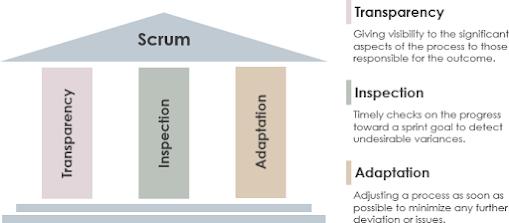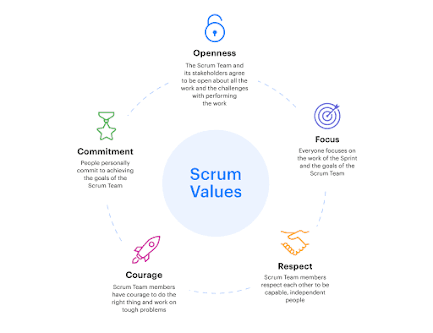What is Scrum ?
Scrum is a light weight agile framework that helps people, organization and team to develop the software in iterative and incremental process.
Three Pillars of Scrum
Transparency - Giving visibility to the significant aspects of the process to those responsible for the outcome.
Inspection - Timely checks on the progress toward a sprint goal to detect undesirable variances
Adaptation - Adjusting process as soon as possible to minimize any further deviation or issues
These three pillars of the scrum is achieved through different ceremonies and artifacts of the scrum.
We can map the pillars as follows
Scrum Values
Scrum is built with following 5 values
Commitment - People personally commit to achieving the goals of the Scrum Team
Focus - Everyone focuses on the work of the Sprint and the goals of the Scrum Team
Openness - The scrum team and its stakeholders agree to be open about all the work and challenges to perform the work
Respect - Scrum Team members respect each other to be capable independent people
Courage - Scrum Team members have courage to do the right thing and work on tough problems
Roles of a Scrum Team - 3 Roles
Scrum team has three roles. ie, Product Owner, Scrum Master and Developers
1. Product Owner - Product owner represents the client interests and prioritizes the product backlog and optimizes the product value. He communicates with different stakeholders such as business owner and end customers
2. Scrum Master - Felicitate the scrum team and help organization to follow scum. He manages the scrum process and removes the obstacles through servant leadership
3. Developers - Self organizing and cross functional team of professionals that helps to meet the Sprint goal.
Responsibilities of Scrum Team
Developer responsibilities
- Creating a plan for the Sprint, the Sprint Backlog;- Instilling quality by adhering to a Definition of Done;
- Adapting their plan each day toward the Sprint Goal;
- Holding each other accountable as professionals.
Product Owner responsibilities
- Developing and explicitly communicating the Product Goal;
- Creating and clearly communicating Product Backlog items;
- Ordering Product Backlog items;
- Ensuring that the Product Backlog is transparent, visible and understood
Scrum Master responsibilities
- Coaching the team members in self-management and cross-functionality;
- Helping the Scrum Team focus on creating high-value Increments that meet the Definition of Done;
- Causing the removal of impediments to the Scrum Team’s progress;
- Ensuring that all Scrum events take place and are positive, productive, and kept within the time-box
Scrum Master serves product owner
- Helping find techniques for effective Product Goal definition and Product Backlog management;
- Helping the Scrum Team understand the need for clear and concise Product Backlog items;
- Helping establish empirical product planning for a complex environment;
- Facilitating stakeholder collaboration as requested or needed.
Scrum Master serves organization
- Leading, training, and coaching the organization in its Scrum adoption;
- Planning and advising Scrum implementations within the organization;
- Helping employees and stakeholders understand and enact an empirical approach for complex work; and,
- Removing barriers between stakeholders and Scrum Teams
Few extra about development Team
- Responsible for achieving the product implementation- Preferably, composed of 5 to 7 members
- Multi-functional - Developers, QA, designers, etc
- Self Organized and Cohesive
- In a spirit of collaboration with common purpose
- No sub teams
- Accountable for delivering PRPI - Potentially releasable product Increment
Scrum Events - 5 Events
1. Sprint
Sprint is one timeboxed iteration of a continuous development cycle. All the work necessary to achieve the Product Goal, including Sprint Planning, Daily Scrums, Sprint Review, and Sprint Retrospective, happen within Sprints.
During the Sprint:
- No changes are made that would endanger the Sprint Goal;
- Quality does not decrease;
- The Product Backlog is refined as needed; and,
- Scope may be clarified and renegotiated with the Product Owner as more is learned
Sprints enable predictability by ensuring inspection and adaptation of progress toward a Product Goal at least every calendar month.
Various practices exist to forecast progress, like burn-downs, burn-ups, or cumulative flows.
A Sprint could be cancelled if the Sprint Goal becomes obsolete. Only the Product Owner has the authority to cancel the Sprint.
2. Sprint Planning
Sprint Planning initiates the Sprint by laying out the work to be performed for the Sprint.
Topic One: Why is this Sprint valuable? (Product Owner)
Topic Two: What can be Done this Sprint? (Developer with product owner discussion)
Topic Three: How will the chosen work get done ? (Developer)
Sprint Backlog = Sprint Goal + Plan for delivering it
Maximum 4 hours for 1 month long sprint
3. Daily Scrum
The purpose of the Daily Scrum is to inspect progress toward the Sprint Goal and adapt the Sprint Backlog as necessary
15 Minutes time
Same time, same place
Daily Scrums improve communications, identify impediments, promote quick decision-making, and consequently eliminate the need for other meetings.
Not mandatory for scrum master and PO to be part of this
4. Sprint Review
The purpose of the Sprint Review is to inspect the outcome of the Sprint and determine future adaptations.
Present their work to stakeholders
4 hours maximum for one month sprint
5. Sprint Retrospection
To plan ways to increase quality and effectiveness
The Scrum Team inspects how the last Sprint went with regards to individuals, interactions, processes, tools, and their Definition of Done.
Discuss what went wrong, what was good
Most impactful improvement are addressed soon, even next sprint itself
3 hours for maximum for 1 month sprint
Sprint Artifacts
Scrum’s artifacts represent work or value. They are Product Backlog, Sprint Backlog and Product Increment.
Each artifact contains a commitment to ensure it provides information that enhances transparency and focus against which progress can be measured:
1. For the Product Backlog it is the Product Goal.
2. For the Sprint Backlog it is the Sprint Goal.
3. For the Increment it is the Definition of Done
1. Product Backlog
The Product Backlog is an emergent, ordered list of what is needed to improve the product. It is the single source of work undertaken by the Scrum Team.
The Developers who will be doing the work are responsible for the sizing. The Product Owner may influence the Developers by helping them understand and select trade-offs.
Commitment : Product Goal - The Product Goal describes a future state of the product which can serve as a target for the Scrum Team to plan against. The Product Goal is the long-term objective for the Scrum Team.
2. Sprint Backlog
The Sprint Backlog is composed of the Sprint Goal (why), the set of Product Backlog items selected for the Sprint (what), as well as an actionable plan for delivering the Increment (how).
Sprint backlog plan is done by and for developers
Highly visible real time picture of the work. It is updated throughout the sprint as learned
Commitment : Sprint Goal - Sprint goal is the single objective for the sprint. Developers keep this goal in mind during the sprint. If there is something turns out wrong to the sprint goal, needs to negotiate with PO without affecting much to the sprint goal.
3. Product Increment
- Increment is a stepping stone towards the product goal.
- A sprint will be having multiple increments
- Increments can be released prior to sprint review
- Multiple increments will be shown during the sprint review event
- Work can’t be part of the increment unless it is met definition of done
Commitment : Definition of Done - The Definition of Done is a formal description of the state of the Increment when it meets the quality measures required for the product.
If a Product Backlog item does not meet the Definition of Done, it cannot be released or even presented at the Sprint Review. Instead, it returns to the Product Backlog for future consideration
To be continued ....






Comments
Post a Comment